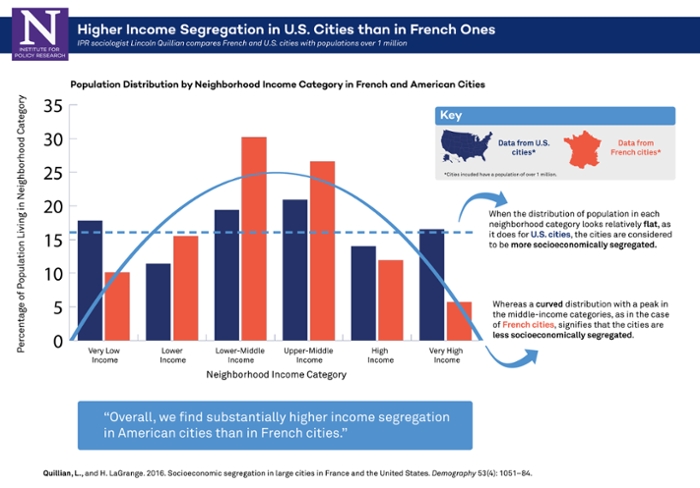Infographic: Income Segregation in French and U.S. Cities
New York and Chicago show higher levels of socioeconomic segregation than Paris or Lyon
Get all our news
Click on the image above to see a larger version of the infographic.
Large U.S. cities are more socioeconomically segregated than French metropolises of the same size, according to research by IPR sociologist Lincoln Quillian published in Demography.
Quillian and his coauthor, Hugues Lagrange of Sciences Po, used data from the American Community Survey, the French Census, and the French Ministry of Finance to compare cities with more than 1 million habitants, or four French cities (Paris, Marseille, Lyon, and Lille) and 51 U.S. cities (including New York, Atlanta, Chicago, and Los Angeles). Within each city, the researchers sorted the population into small “neighborhood” areas of a few thousand inhabitants.
After comparing the median income in each neighborhood with that of the entire city, Quillian and Lagrange assigned each metropolitan neighborhood to one of six income categories, ranging from “very low” to “very high.” They then determined the percentage of the population living in each neighborhood income category in French vs. U.S. cities. Their analysis reveals “strikingly higher levels of residential socioeconomic segregation in the United States than in France.”
While about 50 percent of the population in French cities tends to live in middle-income neighborhoods, U.S. cities have very low and very high income populations that are almost as large as their middle-income population. In general, the most segregated French cities reflect levels of neighborhood income disparity similar to the least segregated U.S. cities.
Though they show U.S. metropolises are more income segregated than French ones, Quillian and Lagrange were only able to hypothesize about the major reasons behind this difference. Their data pinpoint factors that seem more salient than others: For example, race and the organization of urban vs. suburban neighborhoods do affect income segregation to some extent, but are much less influential than the public housing policies of either country—or their respective levels of household income inequality.
Twenty-seven percent of the French urban population captured in the study live in some form of public housing, whereas only 3.5 percent of the U.S. urban population do. This difference, the researchers show, contributes significantly to the levels of socioeconomic segregation in the two countries. While 62 percent of U.S. public housing households live in a low-income bracket area, only 27 percent of French public housing households do.
Importantly, the researchers identify higher levels of income inequality in the United States, regardless of neighborhood. When controlling for overall income inequality in their analysis, U.S. levels of socioeconomic segregation dropped to near-French lows.
While the study makes no direct claims about causality, it does portray the sharp contrast between the large metropolises of both countries and highlights the relatively high levels of residential segregation in the United States. The results also suggest that residential segregation in the United States is an “underappreciated factor” contributing to high levels of inequality and low intergenerational mobility in the United States relative to other affluent countries.
The article, “Residential Segregation in Large Cities in France and the United States,” can be found here.
Lincoln Quillian is professor of sociology and an IPR fellow. Hugues Lagrange is the director of research at the Centre National de la Recherche Scientifique (CNRS) at Sciences Po in France.
Published: May 31, 2017.
